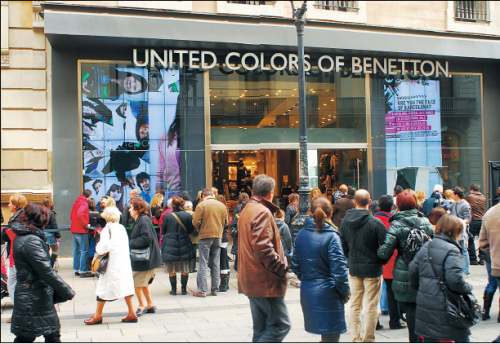
Consultant at Benetton communication research center talks about iconic stores of future
People receive so much input everyday that it is difficult to attract them with something, Alfio Pozzoni told The Korea Herald.
“That is why we have to continuously make improvements in term of contents and surprises.”
Pozzoni, Special Projects Consultant at Fabrica has been leading his team on the Benetton Live Windows Project since last year. He was invited by the Seoul Design Foundation last week to hold a two-day workshop presenting Fabrica’s activities and spearhead projects to an audience of design teachers, professionals and students.
Fabrica is a communication research center opened by the Italian fashion house Benetton in 1994. Pozzoni’s team there installed high-resolution video walls in nine Benetton megastores worldwide, which showcase media art content and allow passersby to interact with the screens.
“The (Benetton) president one day asked us to sit around the table and said that our stores were not so visible anymore. He said we should develop something that could make them more visible even from the street far away, because the competitors were really aggressive,” he said.
Pozzoni came up with the idea of turning the exterior of the stores’ walls into screens, and it hit off. The first ones set in two Milan shops last year were a big hit. Big crowds gathered in front of the stores and they spent lot of time in front of the 120 monitors installed in four big windows. Passersby enjoyed interacting with the screens which captured their movements through cameras, turned them into models in Benetton campaigns or distorted their images.

“They wished to smile and be protagonist but also wanted to take pictures and bring them home or send them by Twitter or Facebook. They enlarged the communication. It was good because they paid more attention to the Benetton store, but we also recognized immediately that we could use the space to promote creativity,” said Pozzoni.
Realizing the effect, Fabrica opened contests where students attending the best design schools in Europe (and now Asia) could send in designs, graphics and photographs to apply for the chance to fill in a certain amount of time on the live windows. Now the video walls in each city are comprised of different contents and themes, which are often very local.
Have market sales increased after the Live Windows were installed?
“I don’t know and I don’t want to know. These answers should not interfere with our creative works. The president said, ‘I want people to see where the stores are,’ he didn’t say that ‘I want to increase market sales.’ This proves that we are at the outside of Benetton, independent from it,” said Pozzoni.
A PR official from the Benetton headquarters said that they had received a good reaction from the customers and that some stores had seen a double digit improvement in sales. The Live Windows can currently be found in nine megastores in Milan, Novara, Munich, Barcelona, Moscow, Shanghai and Bologna.
Fabrica conducted many researches and creative projects on social issues commissioned by organizations like the UNICEF, WHO, or Reporters without Borders, and became a specialist in that area. Many actually join Fabrica to develop experience in the area, and this led onto many of Benetton’s campaigns social issue-dealing-campaigns, said Pozzoni.
“An iconic store is one where you don’t find only merchandise, but can be in wellness and be comfortable, and the things you can see are interesting and stimulating.” he said.
“Designers should research a lot in this field and become more clever in the use of different materials, lights and layers, to create emotion at the atmosphere. Imagine how beautiful it would be to sit in a place where everything is in harmony.”
Smartphones became our second brain, he said, so it is probably the tool that will create content between the store and the customer in the next five years.
“The store can pass the information give discount, offer things, describe philosophy of the company and integrate you to the phone in to the philosophy. Mobile will become the next interface between you and your store.”
By Park Min-young (claire@heraldcorp.com)







![[Graphic News] More Koreans say they plan long-distance trips this year](http://res.heraldm.com/phpwas/restmb_idxmake.php?idx=644&simg=/content/image/2024/04/17/20240417050828_0.gif&u=)
![[KH Explains] Hyundai's full hybrid edge to pay off amid slow transition to pure EVs](http://res.heraldm.com/phpwas/restmb_idxmake.php?idx=644&simg=/content/image/2024/04/18/20240418050645_0.jpg&u=20240419100350)







![[KH Explains] Hyundai's full hybrid edge to pay off amid slow transition to pure EVs](http://res.heraldm.com/phpwas/restmb_idxmake.php?idx=652&simg=/content/image/2024/04/18/20240418050645_0.jpg&u=20240419100350)

![[Today’s K-pop] Illit drops debut single remix](http://res.heraldm.com/phpwas/restmb_idxmake.php?idx=642&simg=/content/image/2024/04/19/20240419050612_0.jpg&u=)